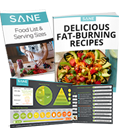In 1998 Coca-Cola offered schools $10,000 to advertise Coke discount cards to their students. Deeply in need of the funds, Greenbrier High School in Augusta, Georgia, invited Coke employees to lecture in classes and added the analysis of Coca-Cola to its chemistry curriculum. The school went on to make all 1,230 students dress in red or white shirts and to spell-out “Coke” while they snapped photos to send to Coke execs.
Considering how harmful and addictive sweeteners are, why was the Coke stunt considered harmless fun while it would be illegal to do the same thing with other harmful and addictive substances?
Sweeteners and tobacco are both harmful and addictive. Yet the promotion of the former is encouraged while the promotion of the latter is highly regulated. The rationale cannot be that tobacco is so much more harmful. Tobacco only kills 8 percent more people. Both industries are even run by the same companies.

Annual Deaths Caused By…
Big Tobacco Taking Over the “Food” Industry
- 1970 – Philip Morris buys Miller Brewing
- 1978 – Philip Morris buys 97% of Seven-Up
- 1985 – R.J. Reynolds buys Nabisco Foods
- 1985 – Philip Morris buys General Foods
- 1988 – Philip Morris buys Kraft, Inc.
- 1990 – Philip Morris acquires Jacobs Suchard
- 1993 – Philip Morris buys Nabisco cereals
- 2000 – Philip Morris buys Nabisco Holdings
Sweeteners and tobacco are even rationalized the same way by industry insiders. Here is how both describe the safety of their products:
They share the same marketing tactics:
And finally, on health:
With so much in common, it seems odd that one of these is treated like the plague while it is fine for the food industry to spend hundreds of millions of dollars per year advertising sweets to children. Particularly when psychologists have shown that before the age of eight, children do not see commercials as marketing, they see them as fact.
Consider the study from the Journal of Marketing thatshowed 70% of six-through-eight-year olds believe fast foods are healthier than food prepared at home. Researcher Kelly Brownell at Yale reports: “A study of Australian children ages nine to ten indicated that more than half believe that Ronald McDonald knows best what children should eat.” He went on to report: “The average American child sees 10,000 food advertisements each year, just on television. Children watching Saturday morning cartoons see a food commercial every five minutes. The vast majority are for sugared cereals, fast foods, soft drinks, sugary and salty snacks, and candy…Between 1976 and 1987, the ratio of high- to low-sugar ads increased from 5:1 to 12.5:1.”
What’s the moral of the story? Food companies are not going to stop with sweeteners. Nor can we rely on our government for help. They are the very source of the guidelines that leave us no practical choice other than to be slathered with sweeteners. It is up to us to end this inSANEity. Let’s get started in the next post.
- “Daily Doc: Lorillard, Aug 30, 1978: ‘The base of our business is the high school student’.” Tobacco.org : Welcome. N.p., n.d. Web. 18 July 2010. <http://www.tobacco.org/Documents/dd/ddbasebusiness.html>.
- “Jan. 4, 1954: TIRC Announced.” Tobacco.org : Welcome. N.p., n.d. Web. 18 July 2010. <http://www.tobacco.org/History/540104frank.html>.
- “Tobacco CEO’s Statement to Congress.” UCSF Academic Senate. N.p., n.d. Web. 18 July 2010. <http://senate.ucsf.edu/tobacco/executives1994congress.html>.
- Ali H. Mokdad; James S. Marks; Donna F. Stroup; Julie L. Gerberding Actual Causes of Death in the United States, 2000 JAMA. 2004;291(10):1238-1245.
- Beck J. Teen suspended from school for wearing Pepsi T-shirt on Coke Day. Chicago Tribune, April 1, 1998.
- Brownell, Kelly, and Katherine Battle Horgen. Food Fight. 1 ed. New York: McGraw-Hill, 2004. Print.
- Donohue, T, Meyer T, Henke L. Black and White Children: Perceptions of TV Commercials. The Journal of Marketing, Vol. 42, No. 4 (Oct., 1978), pp. 34-40.
- Hays CL, McNeil Jr. DG. Putting Africa on Coke’s map. New York Times. May 26, 1998.P. D1.
- Horovitz B. McDonald’s rediscovers its future with kids. USA Today, Apr. 18, 1997.
- National Soft Drink Association web site. Available at http://www.nsda.org/softdrinks/CSDHealth/Index.html.
- Nestle, Marion. Food Politics: How the Food Industry Influences Nutrition, and Health, Revised and Expanded Edition (California Studies in Food and Culture). 2 ed. Berkeley: University of California Press, 2007. Print.
- Simon, Michele. Appetite for Profit: How the food industry undermines our health and how to fight back. New York City, New York: Nation Books, 2006. Print.












